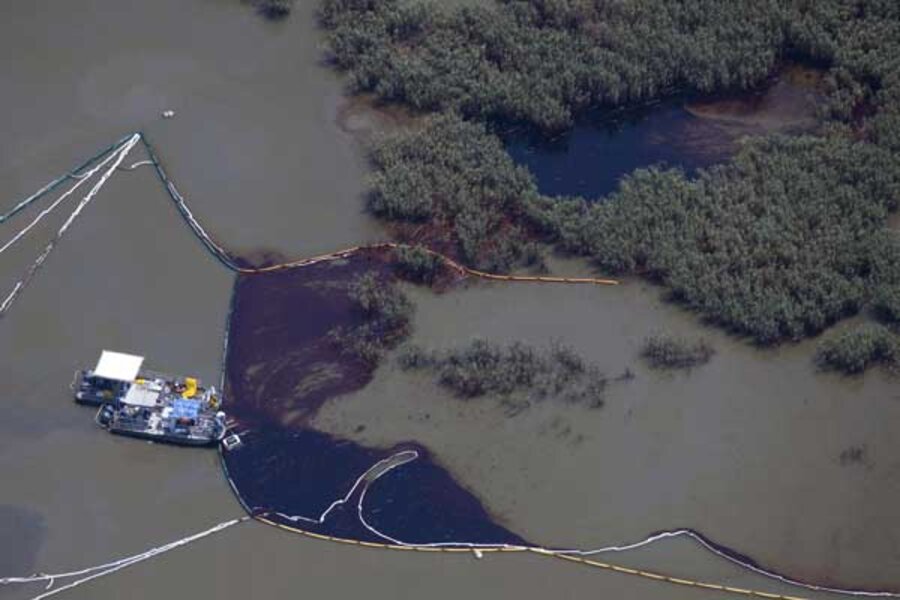How bad is Gulf oil spill? A global Q&A on offshore oil spills
Loading...
| Cairo, Egypt
The Deepwater Horizon oil spill has put a spotlight on the dangerous world of offshore oil drilling. With a well spewing thousands of barrels of crude (estimates range from 5,000 to 100,000 barrels) a day into the Gulf of Mexico, many are wondering if the industry has been too lightly regulated.
The Deepwater Horizon spill is shaping up to be among the biggest in American history - now estimated to be at least 6 million gallons according to US Coast Guard and British Petroleum figures. But such massive blowouts remain rare for offshore rigs. Thousands of drilling rigs operate all over the world every day without disaster. As they pursue oil in deeper waters, however, leaks become more difficult to contain. Safety procedures and clean-up techniques have not kept pace with the race to drill in deeper and deeper waters.
How many offshore rigs are there, and where are they located?
According to Rigzone, an industry website, there are currently about 1,234 exploration rigs. (Spills are more common during exploration, as with the Deepwater Horizon.) One hundred and forty-six are in Europe's North Sea. The Gulf of Mexico is home to 114. The remainder are off the coasts of Brazil, Venezuela, and West Africa; in the Persian Gulf; and in the seas of south and southeast Asia.
IN PICTURES: Louisiana oil spill
What have been the worst spills from offshore oil rigs?
Ixtoc I oil spill, Gulf of Mexico, 1979: Generally considered the second-worst oil spill in history (first is a 1991 disaster at a Persian Gulf oil port during the first Gulf War), the Ixtoc spill occurred when the Mexican state-owned Pemex was drilling an exploratory well in shallow water in the Bay of Campeche. The Ixtoc suffered a blowout, and more than 3 million barrels of oil gushed from the well for more than nine months before engineers were able to cap it. The spill contaminated more than 162 miles of beach in Texas.
Nowruz oil field, Persian Gulf, 1983: After a tanker hit a rig off the coast of Iran, the rig began leaking 1,500 barrels a day. Because Iran and Iraq were at war, the oil flow was not stopped, and the platform was later attacked by Iraqi warplanes. Later, a second platform was attacked, and initially spilled 5,000 barrels a day before slowing to 1,500. Two years passed before Iran capped the wells, but by then some 733,000 barrels of oil had spilled into the Persian Gulf.
Santa Barbara, Calif., 1969: A blowout at a well five miles off the coast of Santa Barbara caused a leak that flowed for 11 days. According to a report by the University of California, Santa Barbara, the spill affected 800 square miles of ocean and coated 35 miles of coastline with oil. It led to the establishment of the Environmental Protection Agency and a moratorium on offshore drilling in California.
Montara, Australia, 2009: An oil well in the Timor Sea, off the coast of Western Australia, began leaking, and the platform subsequently caught fire. The well spewed oil for more than two months, leaking as much as 2,000 barrels a day before it was capped, making it one of the worst spills in Australian history.
Have cleanup and containment methods improved?
The basic techniques used to contain offshore spills haven't changed much in the past three decades, but spills are now tracked by satellite; containment booms stand up better to waves; skimming technology has improved; and chemical dispersants, used to break up the oil into smaller particles, are now less toxic, though they still have a harmful effect on the environment. In the case of the Deepwater Horizon, dispersants have been pumped into the source of the leak for the first time.
Though methods may have been refined and improved, "the techniques are still basically the same," says Gerald Graham, an oil-spill response expert and president of Worldocean Consulting. Recovery rates – how much of the oil is removed from the ocean – haven't improved, says Dr. Graham. He says they still hover at around 10 percent of the total spill.
Jerome Milgram, a Massachusetts Institute of Technology professor who has extensively studied oil spills, says open-water cleanup is tough to improve. "It's never been particularly effective in open waters, and I don't think it ever will be," he notes. Dr. Milgram, who worked to contain the Ixtoc oil spill, says there hasn't been enough research into subsea containment devices.
Have preventive measures improved?
Offshore oil wells have blowout preventers, valves intended to seal off the well if oil or gas begins to flow uncontrollably. Norway and Brazil require a last-resort backup method called an acoustic switch in case the blowout valve fails. The United States does not require rigs to be equipped with these devices.
Andy Radford, senior policy adviser for offshore issues at the American Petroleum Institute, says questions about the reliability of acoustic switches played a role in the US decision not to require their use. But even if the US had more stringent regulations, enforcement would be difficult, says MIT's Milgram: "I haven't the foggiest idea of how to enforce them. You can't send an inspector down 5,000 feet to check a voltage meter on a battery," he says, referring to allegations of a dead battery on one of the Deepwater Horizon's blowout prevention devices.
IN PICTURES: Louisiana oil spill
RELATED STORIES:





